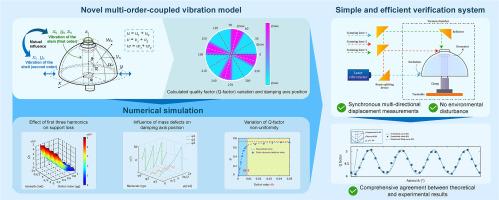Identifying vibration characteristics of hemispherical resonators with mass defects
IF 9.4
1区 工程技术
Q1 ENGINEERING, MECHANICAL
International Journal of Mechanical Sciences
Pub Date : 2025-09-18
DOI:10.1016/j.ijmecsci.2025.110856
引用次数: 0
Abstract
The hemispherical resonant gyroscope (HRG) has become a key component of inertial navigation systems. Existing studies primarily focus on the effects of the first three harmonic components of non-uniform mass distribution defects in the hemispherical resonator. However, the mechanisms by which such defects alter the resonator’s vibration characteristics remain insufficiently characterized and lack robust experimental verification, undermining the accuracy and efficiency of repair and adjustment processes. This study presents a novel analytical framework, which derives multi-order coupled vibration equations for hemispherical resonators with mass defects and develops a comprehensive model to characterize their vibrational behavior. Additionally, a simple yet effective method for identifying mass defects is proposed. For the first time, triangulation consistency among the theoretical model, experimental results, and identification methodology is demonstrated. The proposed characterization model significantly enhances the accuracy of vibration analysis and reveals distinct variations in the quality factor and damping axis orientation due to mass non-uniformity. These findings provide new insights into the coupled vibration dynamics of hemispherical resonators and establish a validated theoretical basis for high-precision and efficient mass trimming techniques, offering valuable guidance for the performance optimization of next-generation navigation systems and other applications requiring precise vibration control.

含质量缺陷的半球形谐振器振动特性辨识
半球面谐振陀螺仪(HRG)已成为惯性导航系统的关键部件。现有的研究主要集中在半球形谐振腔中质量分布不均匀缺陷的前三次谐波分量的影响。然而,这些缺陷改变谐振器振动特性的机制仍然没有得到充分的表征,也缺乏可靠的实验验证,从而破坏了修复和调整过程的准确性和效率。本文提出了一种新的分析框架,推导了含质量缺陷的半球形谐振器的多阶耦合振动方程,并建立了一个综合模型来表征其振动行为。此外,还提出了一种简单有效的质量缺陷识别方法。首次证明了理论模型、实验结果和识别方法之间的三角测量一致性。所提出的表征模型显著提高了振动分析的精度,并揭示了质量不均匀性导致的质量因子和阻尼轴方向的明显变化。这些发现为半球形谐振器的耦合振动动力学提供了新的见解,并为高精度、高效的质量修剪技术建立了验证的理论基础,为下一代导航系统的性能优化和其他需要精确振动控制的应用提供了有价值的指导。
本文章由计算机程序翻译,如有差异,请以英文原文为准。
求助全文
约1分钟内获得全文
求助全文
来源期刊

International Journal of Mechanical Sciences
工程技术-工程:机械
CiteScore
12.80
自引率
17.80%
发文量
769
审稿时长
19 days
期刊介绍:
The International Journal of Mechanical Sciences (IJMS) serves as a global platform for the publication and dissemination of original research that contributes to a deeper scientific understanding of the fundamental disciplines within mechanical, civil, and material engineering.
The primary focus of IJMS is to showcase innovative and ground-breaking work that utilizes analytical and computational modeling techniques, such as Finite Element Method (FEM), Boundary Element Method (BEM), and mesh-free methods, among others. These modeling methods are applied to diverse fields including rigid-body mechanics (e.g., dynamics, vibration, stability), structural mechanics, metal forming, advanced materials (e.g., metals, composites, cellular, smart) behavior and applications, impact mechanics, strain localization, and other nonlinear effects (e.g., large deflections, plasticity, fracture).
Additionally, IJMS covers the realms of fluid mechanics (both external and internal flows), tribology, thermodynamics, and materials processing. These subjects collectively form the core of the journal's content.
In summary, IJMS provides a prestigious platform for researchers to present their original contributions, shedding light on analytical and computational modeling methods in various areas of mechanical engineering, as well as exploring the behavior and application of advanced materials, fluid mechanics, thermodynamics, and materials processing.
 求助内容:
求助内容: 应助结果提醒方式:
应助结果提醒方式:


